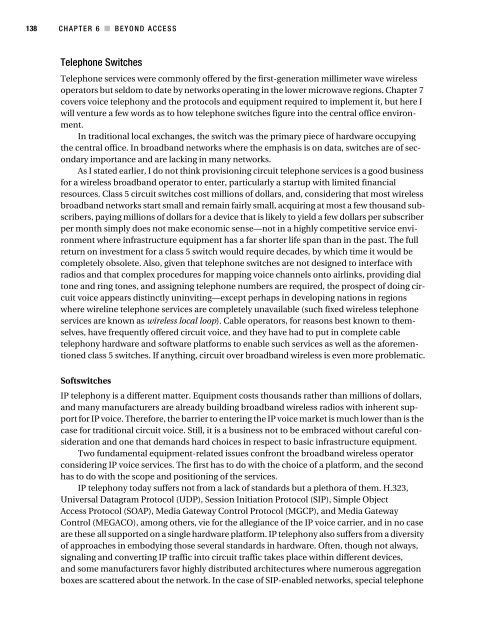WiMax Operator's Manual
WiMax Operator's Manual
WiMax Operator's Manual
Create successful ePaper yourself
Turn your PDF publications into a flip-book with our unique Google optimized e-Paper software.
138 CHAPTER 6 ■ BEYOND ACCESS<br />
Telephone Switches<br />
Telephone services were commonly offered by the first-generation millimeter wave wireless<br />
operators but seldom to date by networks operating in the lower microwave regions. Chapter 7<br />
covers voice telephony and the protocols and equipment required to implement it, but here I<br />
will venture a few words as to how telephone switches figure into the central office environ-<br />
ment.<br />
In traditional local exchanges, the switch was the primary piece of hardware occupying<br />
the central office. In broadband networks where the emphasis is on data, switches are of secondary<br />
importance and are lacking in many networks.<br />
As I stated earlier, I do not think provisioning circuit telephone services is a good business<br />
for a wireless broadband operator to enter, particularly a startup with limited financial<br />
resources. Class 5 circuit switches cost millions of dollars, and, considering that most wireless<br />
broadband networks start small and remain fairly small, acquiring at most a few thousand subscribers,<br />
paying millions of dollars for a device that is likely to yield a few dollars per subscriber<br />
per month simply does not make economic sense—not in a highly competitive service environment<br />
where infrastructure equipment has a far shorter life span than in the past. The full<br />
return on investment for a class 5 switch would require decades, by which time it would be<br />
completely obsolete. Also, given that telephone switches are not designed to interface with<br />
radios and that complex procedures for mapping voice channels onto airlinks, providing dial<br />
tone and ring tones, and assigning telephone numbers are required, the prospect of doing circuit<br />
voice appears distinctly uninviting—except perhaps in developing nations in regions<br />
where wireline telephone services are completely unavailable (such fixed wireless telephone<br />
services are known as wireless local loop). Cable operators, for reasons best known to themselves,<br />
have frequently offered circuit voice, and they have had to put in complete cable<br />
telephony hardware and software platforms to enable such services as well as the aforementioned<br />
class 5 switches. If anything, circuit over broadband wireless is even more problematic.<br />
Softswitches<br />
IP telephony is a different matter. Equipment costs thousands rather than millions of dollars,<br />
and many manufacturers are already building broadband wireless radios with inherent support<br />
for IP voice. Therefore, the barrier to entering the IP voice market is much lower than is the<br />
case for traditional circuit voice. Still, it is a business not to be embraced without careful consideration<br />
and one that demands hard choices in respect to basic infrastructure equipment.<br />
Two fundamental equipment-related issues confront the broadband wireless operator<br />
considering IP voice services. The first has to do with the choice of a platform, and the second<br />
has to do with the scope and positioning of the services.<br />
IP telephony today suffers not from a lack of standards but a plethora of them. H.323,<br />
Universal Datagram Protocol (UDP), Session Initiation Protocol (SIP), Simple Object<br />
Access Protocol (SOAP), Media Gateway Control Protocol (MGCP), and Media Gateway<br />
Control (MEGACO), among others, vie for the allegiance of the IP voice carrier, and in no case<br />
are these all supported on a single hardware platform. IP telephony also suffers from a diversity<br />
of approaches in embodying those several standards in hardware. Often, though not always,<br />
signaling and converting IP traffic into circuit traffic takes place within different devices,<br />
and some manufacturers favor highly distributed architectures where numerous aggregation<br />
boxes are scattered about the network. In the case of SIP-enabled networks, special telephone
















